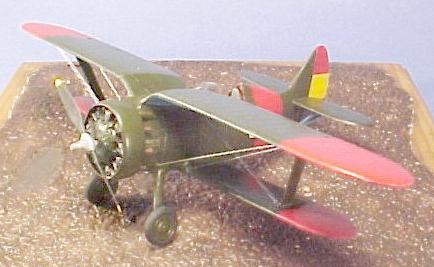
MPM 1/48 Polikarpov I-15
|
KIT # |
? |
|
PRICE: |
$? |
|
DECALS: |
See Review |
|
REVIEWER: |
|
|
NOTES: |
Vacuformed plastic kit, currently OOP. |

So Why Is It The Czechs Make Such Good Plastic Models?
For those who don't know the answer to that question, the reason that - in the past ten years since the overthrow of communism and the end of the Cold War - Czech-based companies have come to dominate the limited-run plastic kit industry and set the standards by which other such companies are judged is that they started the industry a good 20 years previously, as a result of being cut off from western sources for models.
The first time
western modelers became aware of this was in the mid-1970s, when a company
called Kovzavody Prostjetov, or KP, showed up with injection-molded kits
of such aircraft as the MiG-15/17/19, the La-7, the Po-2, and other Soviet types
never before modeled, or never before as accurately - the company was created by
Czech modeling enthusiasts and still exists. The kits had a wealth of surface
detail and seemed to be accurate. Due to the non-convertibility
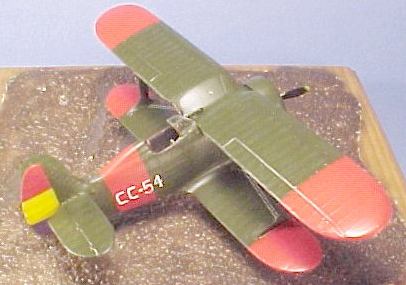 of money between east and
west, the kits were hard to find and harder to come by. I remember exchanging
rock 'n' roll albums and Levis jeans with some Czech modelers who also
subscribed to esoteric little publications like "Small Air Forces Observer." I
like to think that my acts of cultural subversion - small though they were -
helped create what resulted in The Velvet Revolution.
of money between east and
west, the kits were hard to find and harder to come by. I remember exchanging
rock 'n' roll albums and Levis jeans with some Czech modelers who also
subscribed to esoteric little publications like "Small Air Forces Observer." I
like to think that my acts of cultural subversion - small though they were -
helped create what resulted in The Velvet Revolution.
As anyone knows, even limited-run injection-molded kit making is comparatively the most expensive way to go. Other groups of Czech modelers without access to the tools and equipment needed to copy KP went into vacuforms. The "common knowledge" among western modelers is that a vacuform can never compete with an injection-molded kit for quality of detail. These Czechs - having no access to the "common knowledge" of the west and being the inheritors of a very long tradition of wood-carving and fine jewelry-making that involves the creation and use of detailed molds - started carving vacuform molds that resulted in a very high-quality product with regard to surface detail. One of the best of these was a little company in Prague known as MPM.
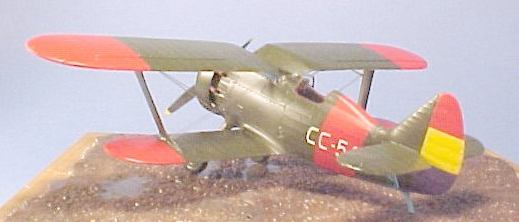 I first became aware
of MPM in 1989, when a friend who regularly traveled to "the other side"
returned with three very nice kits for me - kits of the Polikarpov I-15, I-152
and I-153 in 1/48 scale - which he had picked up knowing how I liked that series
of airplanes and had often bemoaned the impossibility of ever doing a 1/48 kit.
The kits were difficult vacuforms to make, but the models looked very convincing
when completed, In fact, the other week when I was out at Planes of Fame and
happened to see them in a new Soviet Aircraft exhibit in the Model Hall, they
still looked quite convincing, if a bit aged with dust. I also later obtained
their I-16, which to my mind still makes up into the best and most accurate
model of that airplane.
I first became aware
of MPM in 1989, when a friend who regularly traveled to "the other side"
returned with three very nice kits for me - kits of the Polikarpov I-15, I-152
and I-153 in 1/48 scale - which he had picked up knowing how I liked that series
of airplanes and had often bemoaned the impossibility of ever doing a 1/48 kit.
The kits were difficult vacuforms to make, but the models looked very convincing
when completed, In fact, the other week when I was out at Planes of Fame and
happened to see them in a new Soviet Aircraft exhibit in the Model Hall, they
still looked quite convincing, if a bit aged with dust. I also later obtained
their I-16, which to my mind still makes up into the best and most accurate
model of that airplane.
I do not know the internal workings of how this happened, but shortly after The Velvet Revolution, MPM split in two with the founders going their separate ways. One remained as MPM and the other is the company we know as Eduard - they're both still on the cutting edge of quality in detail and the production of models other companies won't touch.
Thus, when I ran across another of the MPM Polikarpov I-15 vacuforms in a box of "old kits" at a dealer's table at a local model show earlier this year, I decided to see how the kit stood up to the developments of the past 13 years since I had first built it, which is how this project came to be.
|
HISTORY |
The products of Nikolai Polikarpov's design bureau of the early 1930s were the first indication that the Soviet aeronautical industry was possibly competitive with that of the west. Dismissed as hopelessly backward, the Polikarpov fighters were a nasty surprise to both the Germans and Italians when they appeared as the equipment of the Republican Air Arm in the Spanish Civil War.
Rather than
revolutionary, Polikarpov's designs were evolutionary, and there was nothing
seen as out of the ordinary in the biplane fighter whose prototype first flew in
October 1933. Powered by an imported Wright SGR-1820-F-3 Cyclone which offered
630 hp at sea level and 715 hp at 6,990 ft., it had 50 percent more power than
the I-5 it was to replace, which had been Polikarpov's first successful design
(as well as his ticket out of detention by the KGB on charges of "sabotage"
after being accused of exercising insufficient energy in bringing assigned work
to fruition). With a wing loading of 11.89 lb/sq ft
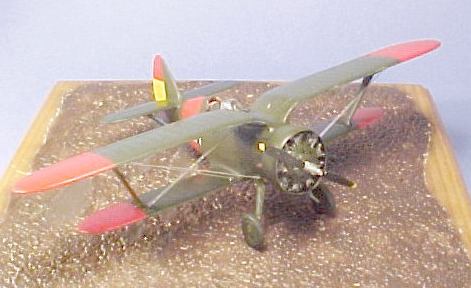 and increased power - as well
as a 4 gun armament with 500 rpg for the upper two and 1,000 rpm for the lower
weapons - the new airplane was faster, more maneuverable and more heavily armed,
making it the equal if not the superior of any fighter then serving in a western
air force. It was assigned the designation I-15.
and increased power - as well
as a 4 gun armament with 500 rpg for the upper two and 1,000 rpm for the lower
weapons - the new airplane was faster, more maneuverable and more heavily armed,
making it the equal if not the superior of any fighter then serving in a western
air force. It was assigned the designation I-15.
Since a license production agreement had not been reached at the time the I-15 entered production in 1934, it was powered by the M-22, a license-built version of the Gnome-Rhone Jupiter 9ASB (itself a French version of the British Jupiter VI). Top speed dropped from 229 mph to 216 mph - still respectable for the time - with no loss in maneuverability. The M-25 - the license-built Cyclone - was finally fitted to the production I-15 in 1936, just in time for the airplane to go to war.
In October 1936, two Soviet freighters docked in Cartagena, Spain, an unloaded their dismantled I-15s. Assembled and flown within days of their arrival, these airplanes transformed the air war from the moment they arrived. Ironically, their impact passed virtually unnoticed in the international press, which erroneously called the I-15s "copies of American types." The I-15 would become known to its opponents as the "Curtiss," in the thought it was a development of a Curtiss design - the Curtiss Hawks thought to be the progenitors of this potent fighter would have been lucky to have half the performance of the I-15.
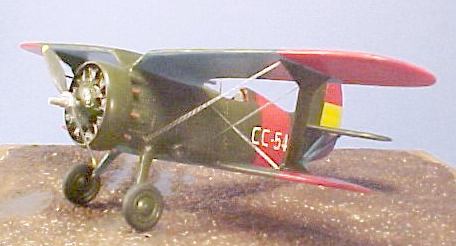 I-15s first fired
their guns in anger on November 4, 1936, when the 2nd Escuadrilla de Chatos
attacked Ju-52/3m's of the Kampfstaffel Moreau, shooting down one of
three and forcing a second to force-land with loss to themselves. Later that
day, two Italian C.R/32s escorting a formation of Ro-37s were intercepted by
seven I-15s, which shot down both C.R.32s and an Ro-37, again without loss. In
a third engagement that day, two more C.R.32s were so badly damaged they
crash-landed back at their base, where they told their incredulous fellow pilots
about a fighter so good it could fly rings around the highly-maneuverable
C.R.32. The next day the largest air battle since World War I erupted south of
Madrid when nine C.R.32s were attacked by 16 I-15s and were joined by five more
C.R.32s. The one Chato lost became the 13th victory of Joaquin Garcia
Morato, the top Nationalist ace of the civil war.
I-15s first fired
their guns in anger on November 4, 1936, when the 2nd Escuadrilla de Chatos
attacked Ju-52/3m's of the Kampfstaffel Moreau, shooting down one of
three and forcing a second to force-land with loss to themselves. Later that
day, two Italian C.R/32s escorting a formation of Ro-37s were intercepted by
seven I-15s, which shot down both C.R.32s and an Ro-37, again without loss. In
a third engagement that day, two more C.R.32s were so badly damaged they
crash-landed back at their base, where they told their incredulous fellow pilots
about a fighter so good it could fly rings around the highly-maneuverable
C.R.32. The next day the largest air battle since World War I erupted south of
Madrid when nine C.R.32s were attacked by 16 I-15s and were joined by five more
C.R.32s. The one Chato lost became the 13th victory of Joaquin Garcia
Morato, the top Nationalist ace of the civil war.
By November 16, the I-15 had demonstrated complete superiority over the Heinkel He-51B that formed the fighter element of the German Legion Condor. The Germans could pay no higher compliment to the Chato than the fact they decided to equip a staffel of Jagdgruppe 88 with the first Bf-109B-1s, even before equipping Luftwaffe squadrons at home, so complete was the superiority demonstrated by the I-15.
This is not to say all the battles went only to the I-15. In its first month of combat, 14 of 62 I-15s available were shot down or severely damaged. By the end of 1936 there were fewer than 30 I-15s operational with the Fuerza Aereas Republicana.
The First American Aces of World War II:
If the Spanish Civil War can be seen in retrospect as the opening act of what would become the Second World War, then the American pilots flying the Chato with the Brigadas Internacionales were the first American aces of the larger war. Almost all their victories were scored in the I-15.
Frank Tinker shot down 3 He-51s, 3 C.R.32s, and two Bf-109Bs, becoming the first American to shoot down a Bf-109.
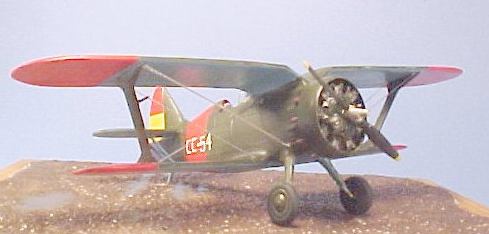 Albert J. "Ajax"
Baumler shot down 3 He-51s and two C.R.32s; in 1942 he was one of the first
pilots assigned to the 23rd Fighter Group in China - successor group of the
A.V.G. - where he scored another 8 victories in 1942-43.
Albert J. "Ajax"
Baumler shot down 3 He-51s and two C.R.32s; in 1942 he was one of the first
pilots assigned to the 23rd Fighter Group in China - successor group of the
A.V.G. - where he scored another 8 victories in 1942-43.
James Peck had 2 He-51s and 3 C.R.32s to his credit.
Orrin B. Bell shot down 7 He-51s on the Cordoba-Granada front.
Harold "Whitey" Dahl also had five kills, including an He-51 and a C.R.32; he was later one of the original Eagle Squadron pilots following his release from a Nationalist prison in 1940.
Due to the political connections of these "premature anti-fascists," their service in Spain was not recognized until many years after the war, when no less a conservative voice than then-General Robert L. Scott Jr. wrote about the combat experiences of his fellow pilot "Ajax" Baumler in China and mentioned his prior service in Spain.
|
THE KIT |
The I-15 kit comes on two thick sheets of white plastic that have the major airframe components vacuformed on them, accompanied by a bag of quite primitive limited-run injection molded detail parts for the engine, landing gear and wheels, prop and cockpit detail, all done in a very soft plastic that looks like chocolate fudge. Decals are provided, but if they were barely-useable 13 years ago, they were impossible to use now. Fortunately, the Spanish Republican insignia can be done with an airbrush and drafting tape.
|
CONSTRUCTION |
This is a "difficult" vacuform. It may have surface detail that is competitive with the best vacuforms available today, but in terms of construction, it requires "old" vac skills, a lot of putty, and an equal amount of patience.
I cut the parts off the vac sheet and sanded them down. I went way down with the wings, horizontal stabilizer and vertical fin/rudder, to get thin flying surfaces with sharp trailing edges when assembled.
I scratchbuilt a cockpit, using Evergreen strip, which I based on the cockpit provided in the Classic Airframes I-153 kit.
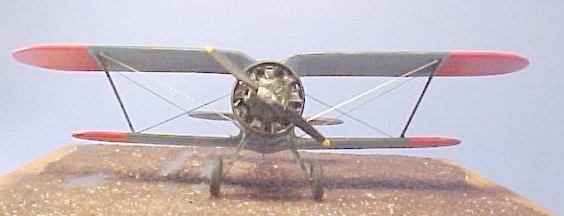 Since the upper wing
is "gulled" into the fuselage, I attached the upper wing before attaching the
lower wings, so I would be able to sand down the putty over the areas where the
two sub assemblies were attached.
Since the upper wing
is "gulled" into the fuselage, I attached the upper wing before attaching the
lower wings, so I would be able to sand down the putty over the areas where the
two sub assemblies were attached.
I then attached the lower wing, which includes the lower forward fuselage, puttied the joints, and sanded them. Once all this was done I rescribed the engraved detail that had been destroyed.
I attached the horizontal stabilizers at this point, and the landing gear legs. The gear legs were strengthened with cyanoacrylate glue around their bases. I also attached the interplane "I" struts.
The cowling is a vacuformed part. I cut it free, sanded down that edge, then sanded out the front opening after very carefully cutting away the excess plastic. When I test-fitted the cowling around the engine, it was way to big, so I cut out about 3/8" from the cowling, glued it back together, and covered the seam with cyanoacrylate glue.
The model was now ready to paint.
|
PAINTING |
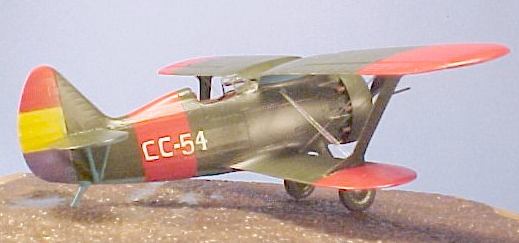 I first "pre-shaded the
model. I then painted the rudder yellow, masking of the center section, then
painted the red areas of the rudder, wing tips and fuselage with Gunze-Sanyo
"Red Madder" and masked them off after I had gone over these areas and "faded"
them. I used Gunze-Sanyo "Purple" for the last color on the rudder and masked
it off.
I first "pre-shaded the
model. I then painted the rudder yellow, masking of the center section, then
painted the red areas of the rudder, wing tips and fuselage with Gunze-Sanyo
"Red Madder" and masked them off after I had gone over these areas and "faded"
them. I used Gunze-Sanyo "Purple" for the last color on the rudder and masked
it off.
The lower color was done with Tamiya "Sky Blue" and the upper color with Gunze-Sanyo "RAF Dark Green," which is close enough for the Russian color, which I "faded" after the first coat.
Since the markings are shown in contemporary photographs to be crudely hand-painted, I hand-painted "CC-54", the markings carried by an I-15 flown by American ace "Whitey" Dahl - these were the only markings I could identify as associated with an American.
The model was unmasked and given an overall light coat of Future.
|
FINAL ASSEMBLY |
I attached the engine to the airframe, and used some evergreen plastic tubing for the exhaust stacks. I attached the wheels, and used a prop out of the spares box that looked better than the very thick prop supplied in the kit. I attached the windscreen with white glue.
Rigging was simple and done with "High-E" guitar string.
|
CONCLUSIONS |
The kit was still as difficult to build as I remembered. The final product looks as good as any contemporary MPM-designed Classic Airframes model like the He-51 in Nationalist markings that this Republican fighter sits next to on the Spanish Civil War shelf. Two friends who have seen the model "in person" were very surprised when they examined the surface detail to discover this was a vacuform model. Only its light weight convinced them.
September 2002
Copyright ModelingMadness.com. All rights reserved. No reproduction in part or in whole without express permission.
If you would like your product reviewed fairly and fairly quickly, please contact the editor or see other details in the Note to Contributors.
Back to Reviews Page 2023